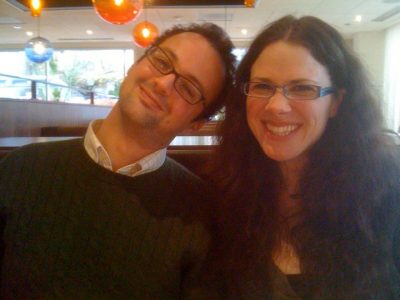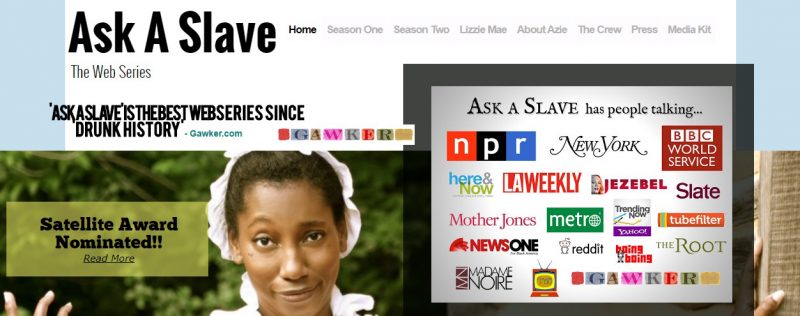Lifting the curtain on living history
29 November 2017 – Andy Urban
Editor’s note: The post is the fourth in a series commissioned by The Public Historian that focuses on essays published in TPH that have been used effectively in the classroom. We welcome comments and further suggestions! If you have a TPH article that is a favorite in your classroom, please let us know. You can send your suggestions to [email protected].

Younger versions of Amy Tyson and Andy Urban eat breakfast at the National Council for Public History annual meeting in Portland, Oregon, March 2010. Photo credit: Kevin Murphy
I’ve known Amy Tyson since we were graduate students at the University of Minnesota. I consider her an old friend at this point, and I am unqualified to deliver an impersonal and unbiased assessment of her scholarly work. Knowing Tyson in this capacity, I do have some thoughts on why her piece for The Public Historian, “‘Ask a Slave’ and Interpreting Race on Public History’s Front Line: Interview with Azie Mira Dungey,” has such appeal as an interview. In this article, Tyson talks with the writer and actor Azie Mira Dungey about the backstory to her web series Ask a Slave. Tyson’s interview with Dungey has become a staple in the Introduction to Public History and Introduction to American Studies courses I have taught the past couple years. When accompanied by the web series itself, the interview offers an accessible account of what it means to confront the various mythologies and public memories that continue to surround the lives and legacies of the so-called “Founding Fathers.”
If you have not watched this series, you should. It explores the interactions that “Lizzie Mae”—Dungey depicting an enslaved housemaid of George and Martha Washington—has with members of the twenty-first-century public. It is based on Dungey’s experiences working as a living history interpreter at the Mount Vernon historic site, where she portrayed Caroline Branham, Lizzie Mae’s real life analogue. The obnoxious, clueless, and dismissive inquiries that Lizzie Mae fields and the show satirizes, punctuated with the occasional good question, derive from actual exchanges that Dungey had.

A screenshot from the homepage of the “Ask a Slave” web series. Taken by Andy Urban
Tyson’s interview with Dungey delves into what it means to labor as a character from the past. When teaching this piece, I like to call my students’ attention to how Tyson uses her shared work background with Dungey to coax detailed answers that give the article its “talking shop” feel. Tyson worked for seven years as a living history interpreter at Historic Fort Snelling in St. Paul, Minnesota, and she is ideally positioned as an interviewer to capture the unique difficulties and joys that this form of labor brings. During the interview, for instance, Tyson introduces a question about the emotional and physical toll that Dungey’s performances took on her by explaining how at the end of a day of work at Fort Snelling, she was often left feeling that “the early nineteenth century was still mapped on my body” (54).
The interview brims with understandings that get at the heart of public history’s political economy. Typically, public historians and living history interpreters are treated as educators and entertainers, but not as workers. This very discourse makes it difficult for professionals working in the field of public history to earn living wages and other benefits, as is often the case throughout the nonprofit sector. The interview does not shy away from this point, but confronts it head on. Dungey relates, for instance, how Black History Month was nicknamed “Black Actor Employment Month” in Washington, DC. Her quip—its humor notwithstanding—illustrates how living history performers of color must operate within a job market that discriminates based on whose stories are told and in what contexts. At another point readers learn that Dungey, during the holiday season, performed a monologue about what Christmas meant to the enslaved Branham as many as sixty-five times an evening. Not surprisingly, she suffered from tracheitis at one point. Teaching this article, I always feel like my job is done when a student directs the class’s attention to the moment where Tyson and Dungey reference, in unison, the burden of having to marshal the energy, no matter how exhausted they might be, to welcome new audiences with an animated “Good day!” Tyson analyzes many of these same themes in her book, The Wages of History, which is an excellent complement to her interview with Dungey.
Dungey’s insights into what it means to portray an enslaved woman—and therefore to embody, as a performer, a character who many contemporary Americans want to ignore as a symbol of the United States’ difficult past—are remarkable. Although there have been important books on how the history of slavery intersects with public memory and engagement, they have for the most part come with the critical distance that is the academic’s luxury. Prior to joining Mount Vernon, Dungey worked as a living history interpreter at the Smithsonian’s National Museum of American History, where she acted the role of a black college student taking part in the 1960 Greensboro lunch counter sit-ins. For the most part, Dungey notes, the Smithsonian’s audiences were able to fit civil rights’ protests into a positive narrative about the American past, whereas at Mount Vernon, the Washingtons’ participation in slavery provoked “defensiveness and a lot of resistance and a lot of shame” (46). In my public history classes, Dungey’s observations about enslaved persons’ marginalization at various historic sites prompt conversations on how this problem might be overcome in practice. I introduce students, for instance, to the recently opened Whitney Plantation in Louisiana, where the whole emphasis is to tell the site’s history from the vantage point of its bonded workforce. Moving beyond the history of slavery specifically, I encourage students to identify a range of living history figures that they think audiences at historic sites and museums would benefit from encountering.
As wonderful as this interview is for undergraduate teaching, it was perhaps most rewarding to assign this piece in the graduate pedagogy seminar that I taught in history last spring. The article became a touchstone, revisited often, for our class’s conversations about the labor of teaching. Whether teaching takes place at a historic site or in a university setting, it will always require instructors to perform emotional labor. Anyone who has ever lectured or led a seminar has surely been reduced to tears, buoyed by elation at a job well done, or saddened by students’ perceived indifference. As our discussion emphasized, when a woman and especially a woman of color enters into a classroom as a teacher, studies have shown that she is far more likely to have her authority and expertise dismissed. For university teachers and living history interpreters alike, the imperative to maintain one’s mental and physical health can sometimes uneasily coexist with a commitment to making sure that the job gets done right and with no shortcuts. Dungey’s observations prompted my students to think long and hard about what it meant to produce historical interpretations for a living.
My (smirking) appeal to Tyson as a friend: time to conduct a follow-up interview? Online research reveals that Dungey has moved on to employment as an executive story editor with the Netflix show Unbreakable Kimmy Schmidt. This represents an intriguing career trajectory for an actor and writer deeply committed to history and is testimony to the fascinating doors that involvement in public history projects might open. Regardless, I hope other scholars will continue to follow Tyson’s lead and interview other public history practitioners about their labor histories. We will all be better professionals for this.
~ Andy Urban is a teacher and practitioner of the digital and public humanities based at Rutgers University. His forthcoming book, Brokering Servitude: Migration and the Politics of Domestic Labor during the Long Nineteenth Century, examines the cultural and political debates that surrounded the commodification of domestic labor in the United States and attempts to regulate markets for the hire of household servants.



